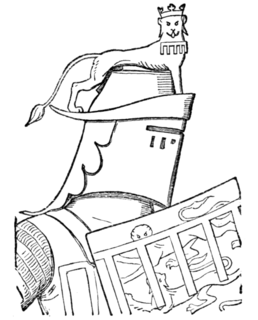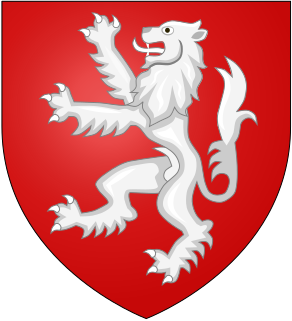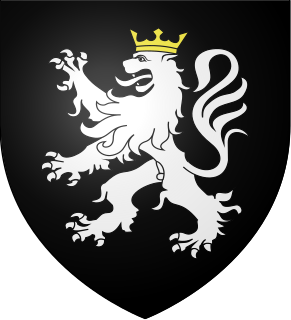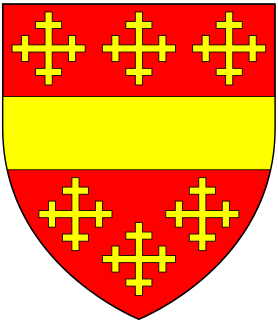Related Research Articles

Thomas de Mowbray, 1st Duke of Norfolk, 1st Earl of Nottingham, 3rd Earl of Norfolk, 6th Baron Mowbray, 7th Baron Segrave, KG, Earl Marshal was an English peer. As a result of his involvement in the power struggles which led up to the fall of Richard II, he was banished and died in exile in Venice.

Earl of Warwick is one of the most prestigious titles in the peerages of the United Kingdom. The title has been created four times in English history, and the name refers to Warwick Castle and the town of Warwick.

The title of Earl of Northumberland has been created several times in the Peerage of England and of Great Britain, succeeding the title Earl of Northumbria. Its most famous holders are the House of Percy, who were the most powerful noble family in Northern England for much of the Middle Ages. The heirs of the Percys, via a female line, were ultimately made Duke of Northumberland in 1766, and continue to hold the earldom as a subsidiary title.

The title Baron Percy has been created several times in the Peerage of England. The first, soon after 1066, a feudal barony rather than a barony by writ, which continued in parallel with the later baronies by writ, until the abolition of feudal tenure by the Tenures Abolition Act 1660. The second, created by writ in 1299, became extinct in 1517. The third, created by writ in 1557, became extinct in 1670. The present creation was in 1722, by writ of summons.

The Lord Warden of the Cinque Ports is a ceremonial official in the United Kingdom. The post dates from at least the 12th century, when the title was Keeper of the Coast, but may be older. The Lord Warden was originally in charge of the Cinque Ports, a group of five port towns on the southeast coast of England that was formed to collectively supply ships for The Crown in the absence at the time of a formal navy. Today the role is a sinecure and an honorary title, and fourteen towns belong to the Cinque Ports confederation. The title is one of the higher honours bestowed by the Sovereign; it has often been held by members of the Royal Family or prime ministers, especially those who have been influential in defending Britain at times of war.

The House of Percy is an English noble family. They were one of the most powerful noble families in Northern England for much of the Middle Ages, known for their long rivalry with another powerful northern English family, the House of Neville.

The House of Mowbray is an Anglo-Norman noble house, derived from Montbray in Normandy and founded by Roger de Mowbray, son of Nigel d'Aubigny.
Margaret de Beaumont, 7th Countess of Warwick or Margaret de Neubourg or Margery de Newburgh was the daughter of Henry de Beaumont, 5th Earl of Warwick and Margaret D'Oyly. She was the sister and heiress of Thomas de Beaumont, 6th Earl of Warwick and became the 7th Countess of Warwick in her own right. She married firstly John Marshal and, secondly, John de Plessis. The latter was a great favourite of King Henry III of England who, in 1247, created him the 7th Earl of Warwick and subsequently Count of Warwick. He died on 20 February 1263. There was no issue by either of these marriages and so, at Margaret's death, the estates passed to her cousin, William Mauduit, who became the 8th Earl.
William Mauduit, 8th Earl of Warwick or William Maudit was an English nobleman and participant in the Second Barons' War.

Nicholas Segrave, 1st Baron Segrave was an English baronial leader. Nicholas was grandson of Stephen de Segrave.
Gilbert Segrave was a medieval Bishop of London. He was the son of Nicholas Segrave, 1st Baron Segrave.

John Segrave, 2nd Baron Segrave (1256–1325) was an English commander in the First War of Scottish Independence.
Isabella de Beauchamp, Lady Kidwelly, Baroness Despenser, was an English noblewoman and wealthy heiress.
Alan la Zouche (1205-1270) was an English nobleman and soldier of Breton descent. He built Zouches Manor.

William III de Beauchamp of Elmley Castle in Worcestershire, was an English baron and hereditary Sheriff of Worcestershire.

Heaton Castle in the parish of Cornhill-on-Tweed, Northumberland, England, is a ruined historic castle near the Scottish border.

Walter de Beauchamp, of Beauchamp's Court, Alcester in Warwickshire and of Beauchamp Court, Powick in Worcestershire, was Steward of the Household to King Edward I from 1289–1303. He was the younger brother of William de Beauchamp, 9th Earl of Warwick (c.1238-1298), the first of his family to hold that title and was the founder of the junior line of the Beauchamp family known as "Beauchamp of Powick".
References
- Matthew Paris (in Rolls Ser.)
- Annales Monastici (in Rolls Ser.)
- Cal. of Close Rolls
- Excerpta e Rot. Finium
- Rôles Gascons (Documents Inédits sur l'Hist. de France)
- Dugdale's Baronage, i. 772-3, and Hist. of Warwickshire, pp. 383–5
- Doyle's Official Baronage, iii. 575-6
- G. E. Cokayne's Complete Peerage, vi. 254
- Foss's Judges of England , ii. 412-4
- Archæologia, xxxix. 428
- Sir Bernard Burke (1883), The Dormant, Abeyant, Forfeited, and Extinct Peerages, 1996 reprint; Plessets, or Plessetis—Earl of Warwick, Baron Plessets; Segrave—Barons Segrave of Barton Segrave; ISBN 0-8063-0789-7
| Peerage of England | ||
|---|---|---|
| Preceded by Margaret de Newburg and John Marshal, jure uxoris | Earl of Warwick 1245–1253 | Succeeded by William Mauduit |
![]()